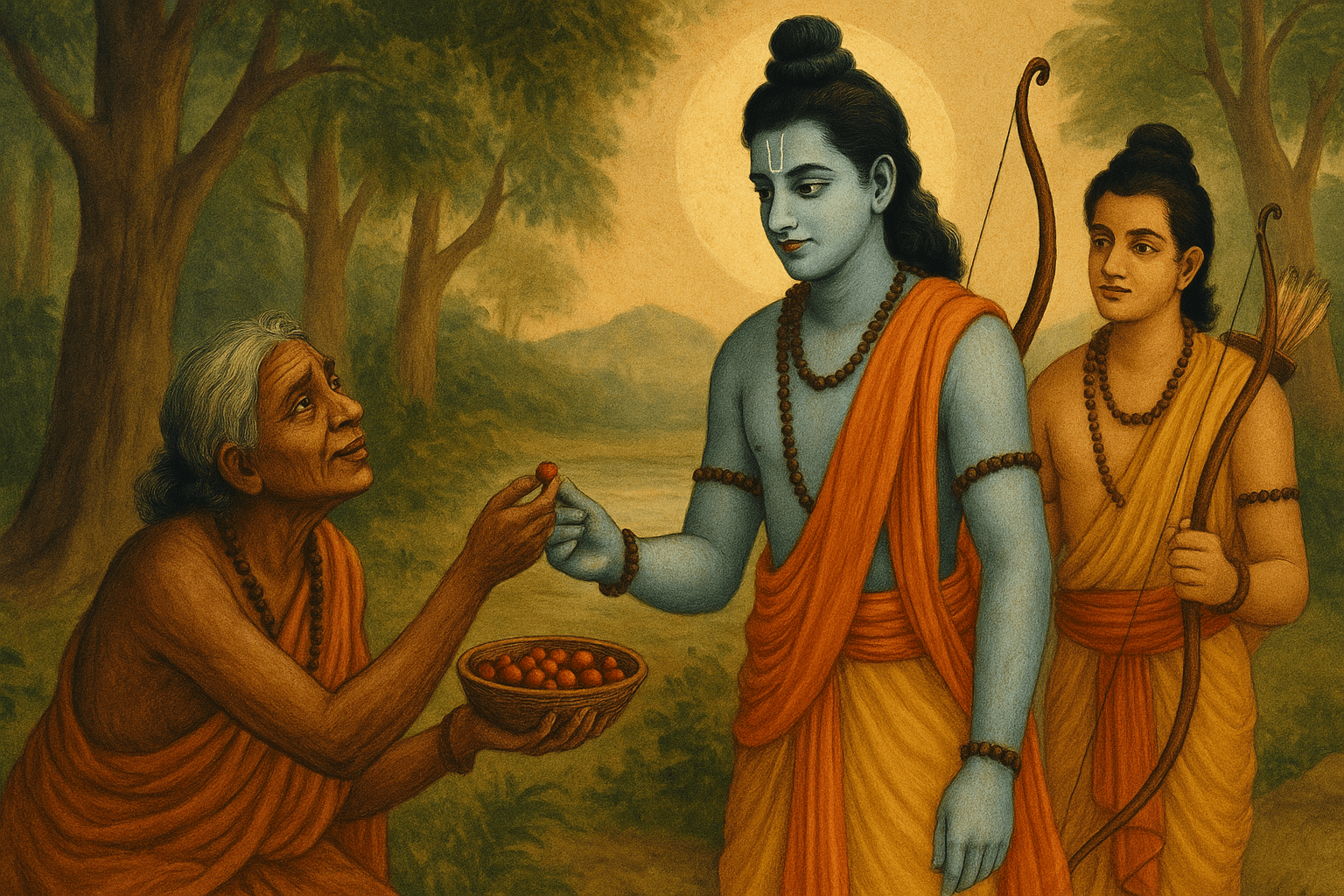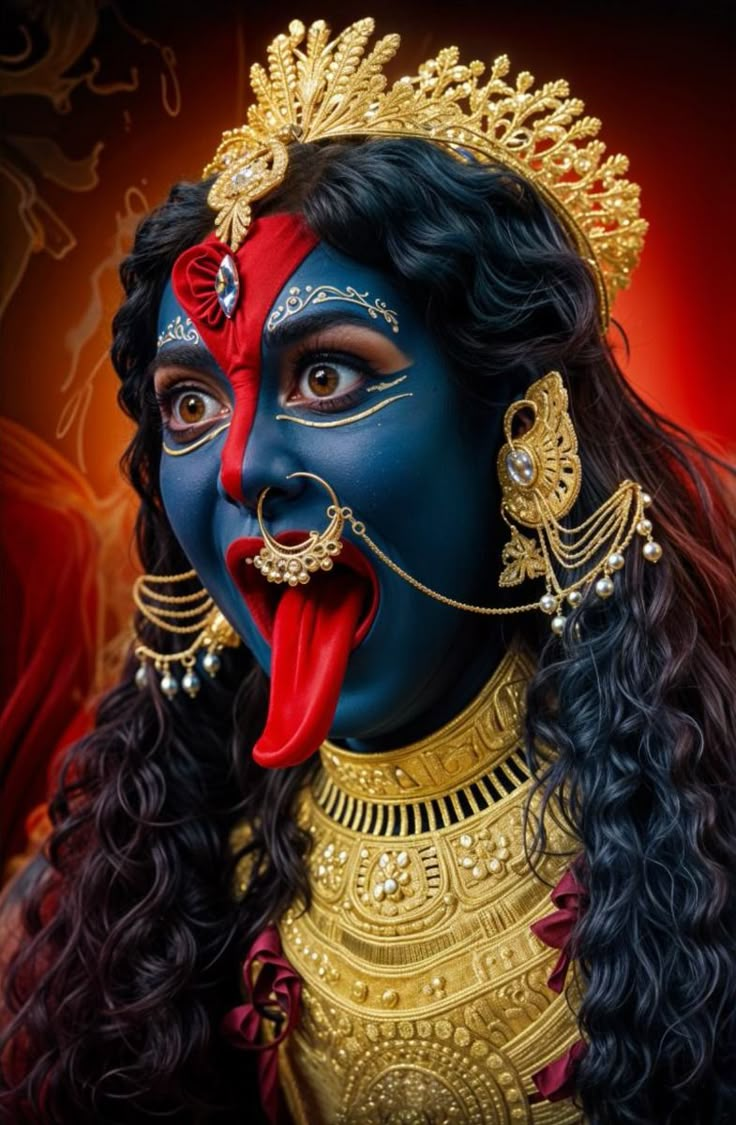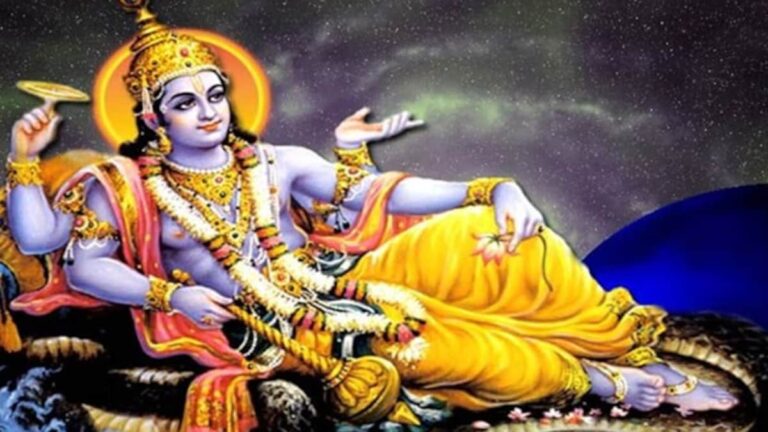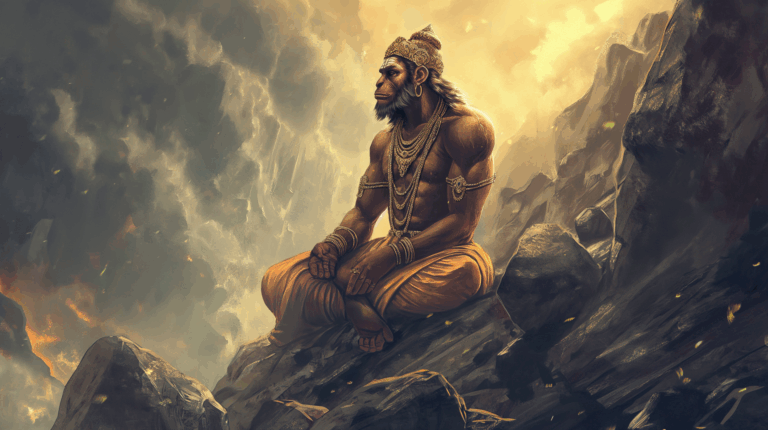In the endless vault of Indian epics, there are grand scenes of celestial warfare, kingship, dharma battles, and divine avatars. Yet, one of the most cherished moments in the Ramayana isn’t a war or coronation—it’s a quiet moment between a divine prince and an old tribal woman, Shabari. A scene that melts the heart more than any heavenly miracle: Lord Rama accepting her humble offering of forest berries.
Why would the prince of Ayodhya—descended from the Sun God himself, raised in opulence, and destined for kingship—choose hand-picked, half-eaten berries over royal delicacies? What makes this act so spiritually magnetic that it remains one of the most loved vignettes of Indian lore?
This post dives into the essence of this moment—what it tells us about Lord Rama, about devotion, about food, love, discrimination, and the very soul of Hindu spirituality.
The Scene: A Forest Hut, A Tribal Woman, and the Divine Guest
Shabari was not a queen, nor a sage by traditional means. She was an elderly woman from a tribal background—an outcast by social standards—who had spent her entire life waiting for Lord Rama. Guided by her guru, Rishi Matanga, she lived with one goal: to someday see Rama, serve him, and surrender to him. After her guru attained Samadhi, she stayed behind in the hermitage, cleaning the path every day in anticipation of her Lord’s arrival.
One day, Rama came—tired, exiled, and searching for Sita. And she was ready.
Her only offering? Berries she had tasted one by one, to ensure none were sour. In any other house, this would be offensive. In dharmic tradition, feeding someone half-eaten food is considered highly impure. But Rama not only accepted the berries—he smiled, he blessed her, he relished them.
What was so sacred in this act?
Lesson 1: Bhakti Above Ritual
This moment is the beating heart of Bhakti Yoga. Hindu philosophy acknowledges many paths to the divine: Jnana (knowledge), Karma (action), Raja (meditation), and Bhakti (devotion). Shabari walked the path of Bhakti, and walked it perfectly.
She had no scriptures, no Sanskrit mantras, no yagnas. Her puja was patience. Her mantra was Rama’s name. Her temple was the forest. Her offering was her love.
Rama’s acceptance of her food wasn’t just kindness—it was an acknowledgment that pure devotion outweighs ritualistic purity.
Lesson 2: Equality in the Eyes of the Divine
Caste and status have long been abused in the name of religion, but Shabari’s story demolishes this illusion. She was not born a Brahmin, nor trained in Vedic customs. And yet, she attained what the greatest sages sought—a direct darshan of the divine.
The Ramayana here breaks the barrier of caste-based superiority. It shows that God sees not your birth, but your heart. It is a sharp reminder that spiritual merit is measured in humility and love, not in lineage.
Shabari didn’t reach the divine despite her tribal birth—she reached because of her unshakable faith, which no social barrier could diminish.
Lesson 3: The Taste of Love Is Sweeter Than the Taste of Food
Why did Rama enjoy the berries?
Because they were soaked in love.
In spiritual psychology, the intent behind an action carries more energy than the action itself. In the Bhagavad Gita, Krishna says:
“Patram pushpam phalam toyam yo me bhaktya prayacchati
Tad aham bhakty-upahritam ashnami prayatatmanah”
(BG 9.26)
“Whoever offers Me a leaf, a flower, fruit or water with devotion, I accept it with love.”
It’s not about the leaf. Or the flower. Or the berry. It’s about bhakti—devotion. Shabari’s berries were infused with such deep love that even the most luxurious royal spread would seem bland in comparison.
Rama wasn’t tasting the berries.
He was tasting her heart.
Lesson 4: Waiting for the Divine is a Form of Sadhana
Shabari waited for years. Her guru had left his body. There was no guarantee Rama would ever arrive. Yet, she swept the path every morning, hoping that today might be the day.
Her waiting was not passive—it was an active, living faith. A kind of tapasya without fire, but burning just the same.
This teaches us something profound: devotion is not just about rituals, but about readiness.
Are we ready to receive grace?
Have we cleared the path in our hearts?
Shabari didn’t know when the Lord would arrive—but she kept her home ready, just in case. And so, he did.
Lesson 5: Shabari Wasn’t Poor—She Had the Richest Offering
From a material standpoint, she had almost nothing. No wealth. No ornaments. No grand temple. But spiritually, she offered more than kings:
- Her patience was worth more than gold.
- Her simplicity was more dazzling than jewels.
- Her faith built a temple in the wilderness.
In choosing her berries, Rama showed that real wealth is measured in sincerity.
Lesson 6: The Breaking of Social Conditioning
When Rama eats the tasted berries, he also breaks religious dogma. Not to insult tradition—but to elevate love above rules.
This story forces the listener to ask:
Why do we think some foods or hands are impure?
Who defines purity?
Is something more sacred because it’s made in a silver plate, or because it was offered with tears of devotion?
Rama, being dharma incarnate, showed that love is the highest dharma.
The Symbolism: What Are You Feeding God?
Shabari’s offering was not just food. It was her life. Every moment she waited, every thought she had, every step she swept—she served that to the Lord in the form of berries.
We all offer things to God. Flowers, sweets, coins.
But what is the real offering?
- Do we offer our attention?
- Do we offer our time?
- Do we offer our ego?
Shabari offered her whole being. That’s why Rama ate.
The Legacy of Shabari
Even today, her story is recited in satsangs and bhajans, not as a footnote in Rama’s exile, but as one of the finest examples of Bhakti ever lived. Her hut is visited by pilgrims, her name sung by saints. She may not have fought wars or written scriptures, but in one gesture of love, she attained what others strive for across lifetimes—God’s smile.
What It Means For Us
You don’t need to be a priest to connect with the divine.
You don’t need to chant a thousand shlokas.
You don’t need a golden temple.
You need a heart like Shabari’s—humble, open, patient, pure.
This is why Lord Rama preferred her simple berries over royal feasts.
Because what matters to the divine isn’t what’s on the plate,
but what’s in your heart.







